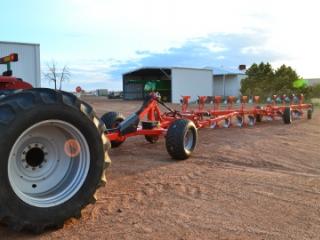Inversion ploughing
In suitable soil types, weed seed burial is an effective method of killing weed seeds particularly if herbicide resistant weeds are problematic.
Inversion ploughing to bury weed seed
Inversion ploughing is used to fully invert the soil to ensure weed seeds that were on or just below the soil surface are placed at a depth where they cannot germinate. This can be practiced every 8-10 years, with conservation tillage used in the intervening years. In WA, annual ryegrass seeds failed to establish and eventually died when soil was fully inverted to a depth greater than 20cm using a specialist mouldboard plough fitted with skimmers. This single soil inversion event reduced annual ryegrass numbers by more than 95% at Katanning and Beverley, Western Australia, for a period of two years.
Benefits
- In suitable soil types, weed seed burial is an effective method of killing weed seeds.
- Disease and insect control occur due to the burial of stubble.
- Non-wetting soils are ameliorated.
- Nitrogen mineralisation occurs.
- Nutrient stratification in the soil is removed (that is, mixing nutrients usually concentrated in the surface).
- There are opportunities for soil ameliorant (for example, lime) application at depth.
- Inversion ploughing leads to green manuring and incorporation of organic matter into the soil.
Issues to consider
- Inversion ploughing of windrows will reduce weed numbers with minimal paddock disturbance, but weed seeds will remain in the inter-windrow area. Inversion of windrows is a more effective weed control method than burning residues.
- Appropriate soil type is needed for effective soil inversion. Soil inversion is limited to soil types where there is sufficient topsoil to allow full inversion. Shallow duplex soils where the clay is less than 15cm deep for example, are unsuitable. It is also difficult to achieve the complete inversion needed for effective weed control in soils with a large number of rocks and/or stumps.
- In situations where soils exhibit problems at depth (for example, clay, sodicity, salinity, boron, magnesium, manganese), soil inversion should be avoided as it may bring these problems to the surface. Growers should conduct soil tests where problems are suspected.
- Soil inversion is most effective in reducing weed seedbank numbers with limited dormancy. For those species with dormant seeds, a reinversion in later years may bring viable seeds back to the surface.
- Careful timing of inversion ploughing will reduce the risk of wind and water erosion.
- Inversion ploughing is best performed just prior to sowing once the soil profile has become wet.
More information can be found at GRDC IWM hub: Managing the weed seedbank.

